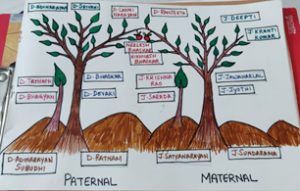The children identified what is a family, and then understood the concept of the family tree. They created a family tree not just from the father’s side but also related to the mother’s mother.
We discussed not just family but what work the different (living) family members do now. The children also found out and recorded where their family members in the chart were born and where they are now. They also asked their parents and grandparents what they did, what was their daily time table when they were the child’s age. Of course, the children also had to draw up their daily table, so this was a comparison point.
They recorded what similarities they have with different family members, and what they have learnt from them.
We did not expect the children to “know” all of these when we asked these. Finding out this information was their assignment. Such assignment led to conversations within the family, and also exposed them to the social and lifestyle changes that have happened in the last sixty years.
The understanding of the family tree evolved as seen by these pictures within a few weeks.
The learnings, however, went beyond the relationships within the family. They learnt about society and environment in their parents’ and grandparents’ times. They learnt how daily activities have evolved, and about other villages, towns and cities that their family members lived in. They learnt about other professions. In short, they were introduced to a contextual understanding of their own family members. They may not have the maturity to reflect or analyse at the moment, and that will probably happen as they grow up.
The concept of “Near to Far” is from Sri Aurobindo’s education philosophy. Our students got exposed to relationships, professions, geography and social practices in a context “near” to them, before they set out for the wider exposure to these.


